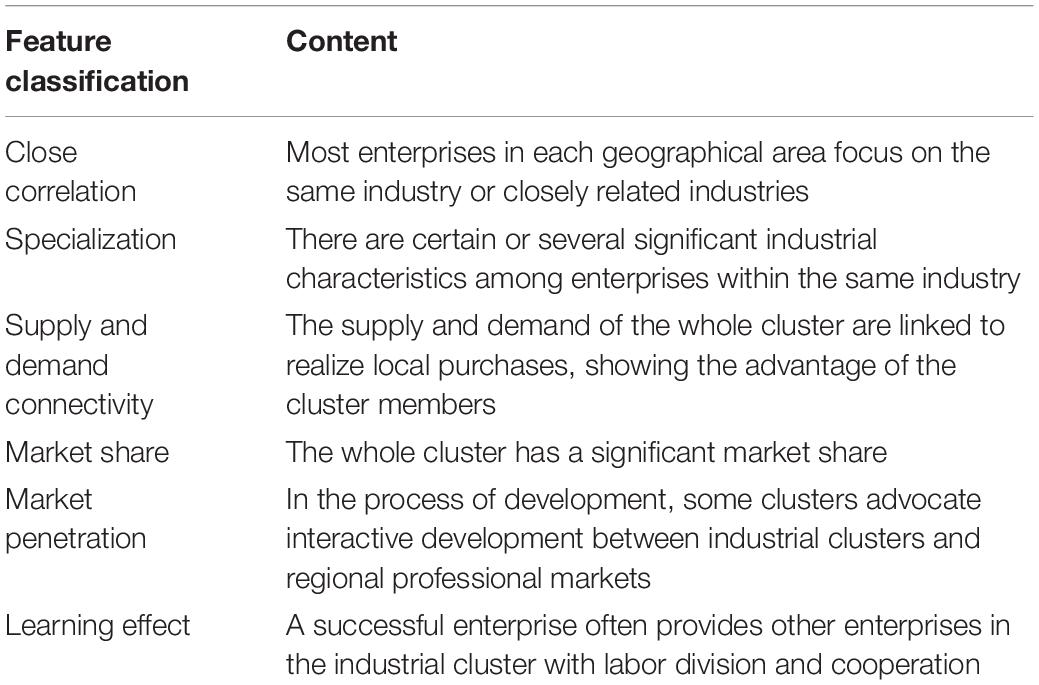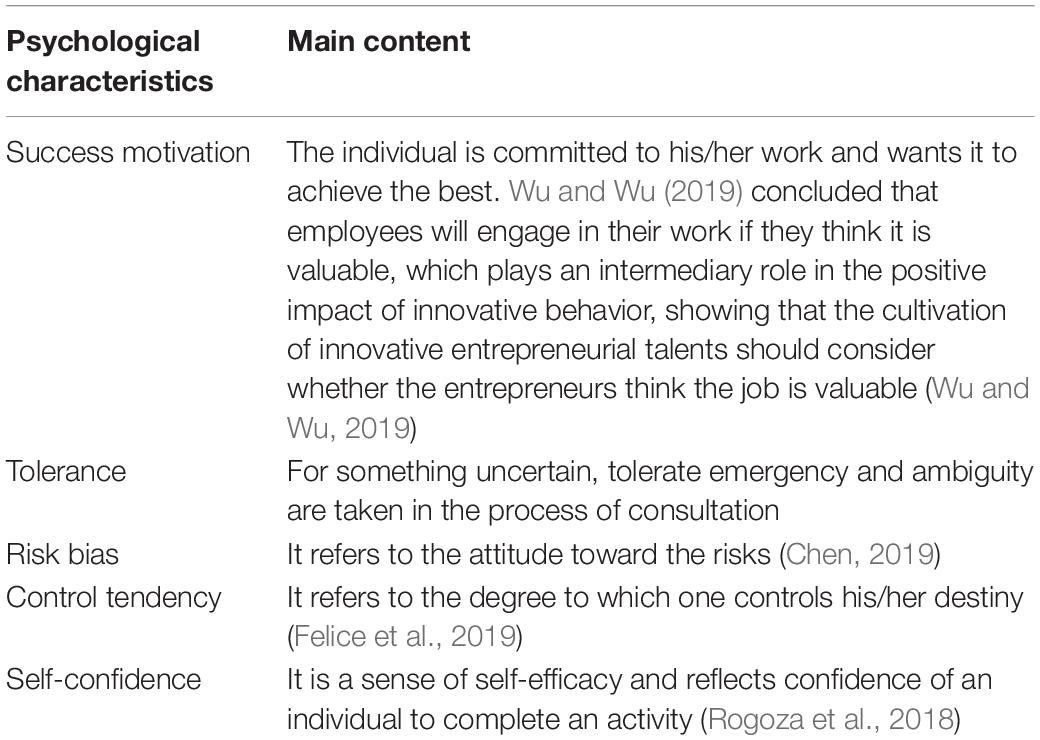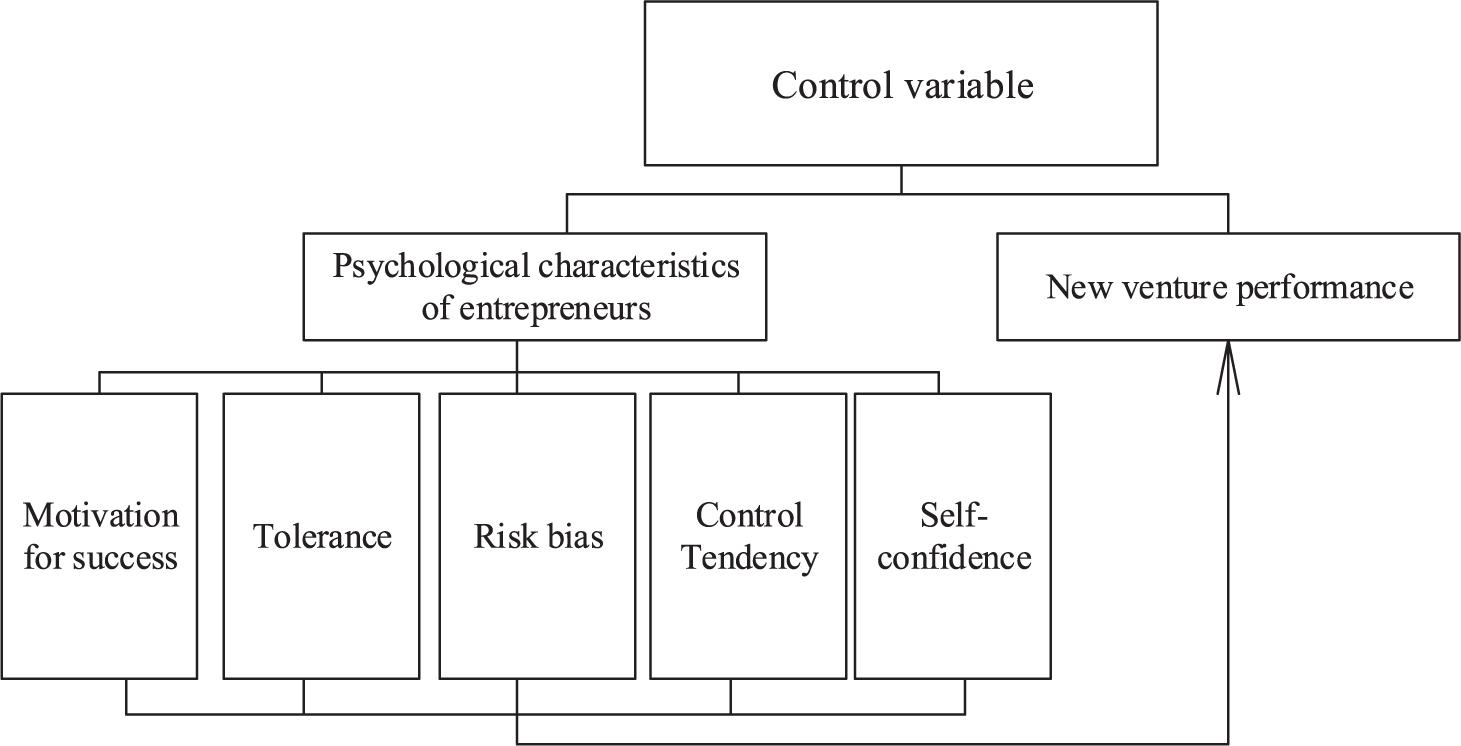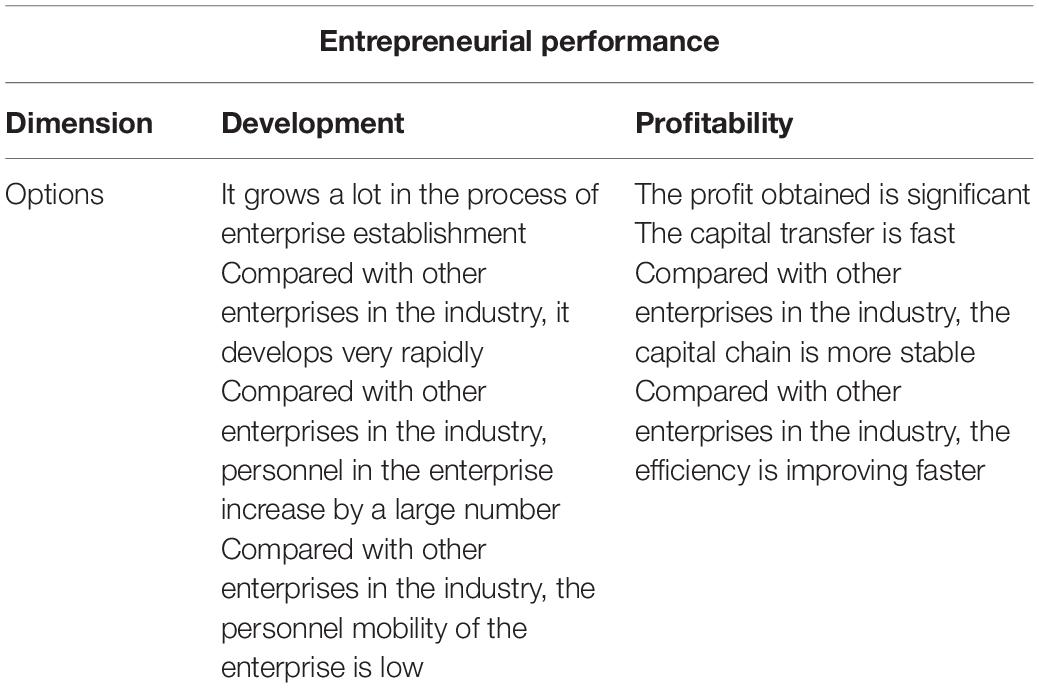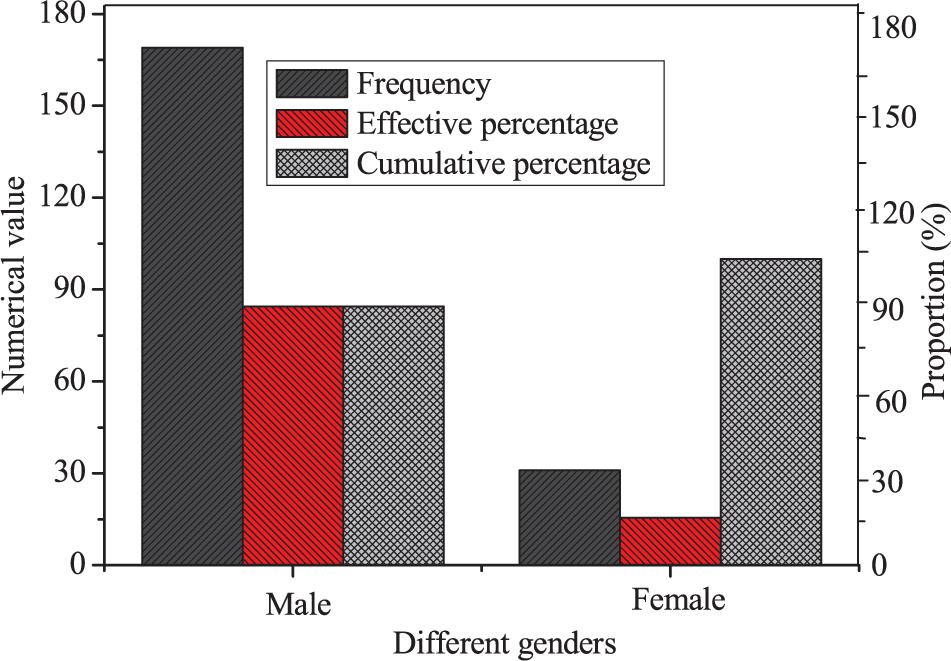- School of Economics and Trade, Henan University of Technology, Zhengzhou, China
This study aims to analyze the influencing factors and training plans of cultivating new entrepreneurs in the new era based on industrial cluster theory. First, the status of the research on the correlation between psychological characteristics and entrepreneurial performance of new entrepreneurs is reviewed. Second, 200 new entrepreneurs in the Xi’an City of Shaanxi Province are randomly selected as the research objects. An empirical model of the correlation between entrepreneurial psychological characteristics and entrepreneurial performance is innovatively proposed. Finally, the questionnaire data are analyzed by correlation analysis and SPSS 26.0 (Chicago) statistical analysis. The results show that most of the entrepreneurs are between 30 and 50 years old, with a larger number of mens, and most graduate from junior colleges. The gender and education level of the new entrepreneurs have a little impact on their entrepreneurial performance (P > 0.05), whereas their age has a significant impact on their entrepreneurial performance (P < 0.05). Moreover, there is a significant correlation between the psychological characteristics of the entrepreneur and the two dimensions of entrepreneurial performance (development and profitability) (P < 0.05). This shows that the key to cultivating new entrepreneurs is to develop their age and psychological characteristics, which can enhance the entrepreneurial ability of new entrepreneurs and provide a basis for cultivating multidimensional entrepreneurial talents in new enterprises.
Introduction
An industrial cluster means that enterprises or factories share some production resources through geographical aggregation. Some scholars believe that the competition and cooperation in the same industry and on the social network are based on trust, sharing professional labor, resources, and knowledge. Which countries should be chosen is a matter that China needs to be fully considered (Qu et al., 2017). Cluster planning becomes a method of formulating development policies by the government. The United Kingdom, the United States, the European Union, and other developed countries promote the development of national innovation industries by establishing high-tech zones, and their successful experience is quickly imitated by developing countries (Mayhew et al., 2016).
Although it has a positive development trend, the industrial cluster of China still has some problems. Zhang and Hu (2017) argued that the lack of innovation mechanisms and the construction of an entrepreneurial environment are still problems that cannot be ignored in the industrial clusters of China. Most of the industrial clusters lack innovative ability, and the gap between the advanced industrial clusters of the world is great (Chen and Xin, 2019). Iodice et al. (2017) found that the ability of research and development and the transformation rate of scientific and technological achievements of the industrial cluster of China should be improved. In addition, Park (2017) mentioned that innovation ability, cluster location selection, cluster subject relationship, and interaction intensity, and the availability of venture capital have a major impact on the transformation efficiency of scientific and technological achievements in China. These factors need to be further analyzed and given more attention to the industrial parks of China (Iodice et al., 2017; Park, 2017). Compared with the developed industrial clusters in the world, the industrial clusters of China still have a long way to go, because the competitiveness, especially the international competitive ability, is still weak (Redondo, 2019).
The primary problem to be solved in improving the ability of industrial clusters of China is to construct an entrepreneurial environment. Entrepreneurs, as the promoters and implementers of constructing an entrepreneurial environment, play an important role in entrepreneurial activities, and they can more effectively identify opportunities, allocate resources, think about strategies, and ultimately create new businesses. In this case, start-ups not only achieve economic development but also realize their goals and give full play to their potentials (Yuan et al., 2020). After the studies on entrepreneurship are reviewed, it is found that most of them are about the entrepreneurial phenomenon, entrepreneurial behavior, entrepreneurial environment, or the induction of foreign entrepreneurial research. The discussions on the relationship between the demographic characteristics of entrepreneurs and the natural characteristics of entrepreneurs are inadequate (Hashai and Markovich, 2017; Shen et al., 2019).
In short, there are some problems in industrial clusters of China, such as the lack of innovation mechanism, the low transformation rate of scientific research results, the lack of international competitiveness, and the lack of research on the relationship between demographic characteristics of entrepreneurs and the natural characteristics of entrepreneurs. Therefore, based on the characteristics of industrial clusters in the new era, a multidimensional structure empirical model of the correlation between entrepreneurial psychological characteristics and entrepreneurial performance is put forward, and it is also the innovation point of the study. The influencing factors of the psychological construction of new entrepreneurs are analyzed, providing the basis for improving the efficiency of new enterprises.
Materials and Methods
Industrial Cluster Theory From the Perspective of Agglomeration in the New Era
Cluster planning can improve the transformation rate of scientific and technological achievements. However, the industrial cluster ability of China is relatively weak, as mentioned in the introduction part of the article. Therefore, the industrial cluster theory in the new era is analyzed, and this provides a theoretical basis for cultivating new entrepreneurs for enterprises.
An industrial cluster refers to a group of enterprises, professional suppliers, service providers, financial institutions, manufacturers of related industries, and other related institutions that are geographically concentrated in a specific region and have competitive and cooperative relations. The development level of the industrial cluster becomes an important investigation indicator of a region and an economic union (Panda and Nagendra, 2017; Yang and Dunford, 2017), as shown in Table 1.
Research Status of the Correlation Between the Psychological Characteristics of New Entrepreneurs and the Performance of New Ventures
The characteristics are the personality of an individual, and it is formed by a variety of rational characteristics under the interaction of heredity and environment (Link and Lashley, 2016). Performance refers to achieving a predetermined goal or completing a specific task, and it is usually functional or effective. The purpose of all business operations is to improve the performance of enterprises. Entrepreneurial performance is usually used as the indicator of organizational activities to evaluate the operation of new enterprises. Thus, entrepreneurial performance is the main reference standard to measure the success of entrepreneurial activities (Or et al., 2015; Przepiorka, 2016).
The potential characteristics of entrepreneurs are constantly shown in entrepreneurial practice. Entrepreneurs give full play to their characteristics, figure out the entrepreneurial opportunities in a complex environment, and take full advantage of entrepreneurial resources to establish new enterprises successfully and achieve economic and social profits (Ratna, 2018). Some researchers propose that the dependence of entrepreneurs on resources and personal characteristics has a great impact on the success of enterprises, and it also plays an important role in promoting the development and growth of science and technology (Heinz et al., 2017; Lv et al., 2021).
The current studies have a remarkable disconnect between psychological characteristics and entrepreneurship. Wu et al. (2019) studied the relationship between a certain dimension of psychological capital of an entrepreneur (such as entrepreneurial self-efficacy) and the performance of new ventures and pointed out that entrepreneurial self-efficacy plays a mediating role in the positive impact of entrepreneurial education behavior. Nevertheless, the number of studies is small, and the conclusions are inconsistent. Besides, the existing entrepreneurship research focuses on the impact of entrepreneurial personality, entrepreneur human capital and social capital, entrepreneurial environment and entrepreneurial strategy, and the performance of new enterprises, ignoring the role of entrepreneurial psychological characteristics (Ogas et al., 2019).
Establishment of Research Model and Hypotheses
1. Based on the review of entrepreneurship research, some psychological characteristics for entrepreneurial success are summarized (Labrador et al., 2016; Mooradian et al., 2016), and the entrepreneurial psychological characteristics are analyzed from the five perspectives, namely success motivation, tolerance, risk bias, control tendency, and self-confidence, as shown in Table 2.
The empirical model established in the study is shown in Figure 1.
2. Two dimensions of entrepreneurial performance are selected to analyze the dimensions, and they are development (Friedman et al., 2016) and profitability (Chen et al., 2017). The growth indicators can reflect the entrepreneurial process of enterprises. The above two dimensions are scored by the Likert 5-point system. The entrepreneurial performance is shown in Table 3 and includes two dimensions, namely development and profitability. Each dimension has four options numbered A, B, C, and D. The development dimension tells the growth of entrepreneurs, the development speed of enterprises, the increase of the number of employees, and the mobility of employees, whereas the profitability shows the profit of enterprises, capital turnover, and capital linkage and benefit growth.
3. The research hypotheses are brought up. The essential characteristics of entrepreneurs are gradually strengthened in the continuous entrepreneurial practice. The personality embodied in the theoretical characteristics enables entrepreneurs to identify entrepreneurial opportunities in a complex environment, make full use of entrepreneurial resources, and successfully set up innovative enterprises (Wu and Song, 2019). Moreover, entrepreneurial performance is also reflected in the entrepreneurial process. Based on the analysis, the following question is asked: Will entrepreneurial characteristics affect entrepreneurial performance?
The corresponding hypotheses are proposed:
H1: The psychological characteristics of new entrepreneurs have an impact on the development of the enterprise.
H2: The psychological characteristics of new entrepreneurs have an impact on the profitability of the enterprise.
4. The questionnaire is designed, and the scales are designed according to five main psychological characteristics, as shown in Table 4.
Analysis Tools
1. Confirmatory factor analysis is used to test the validity of the scale, and the Cronbach’s α value tests the reliability.
2. Hypotheses H1 and H2 are verified by correlation analysis. Correlation analysis explores whether there is a correlation between two variables. As the scores of psychological characteristics and entrepreneurial performance are continuous variables, their correlation is verified by Pearson’s difference product correlation method. The higher the absolute value of Pearson’s correlation coefficient, the stronger the correlation between the two variables is, and vice versa. The t-test is used to analyze the influence of the gender of the entrepreneur on different psychological characteristics, and one-way ANOVA is used to test the influence of the age and education level of the entrepreneur on different psychological characteristics.
3. SPSS 26.0 statistical software is used for analyzing the collected questionnaire data and Origin 2018Bit for visualizing the data.
Results and Analysis
Reliability and Validity of the Questionnaire
The reliability and validity of the questionnaire are analyzed, and the results are shown in Figures 2A,B.
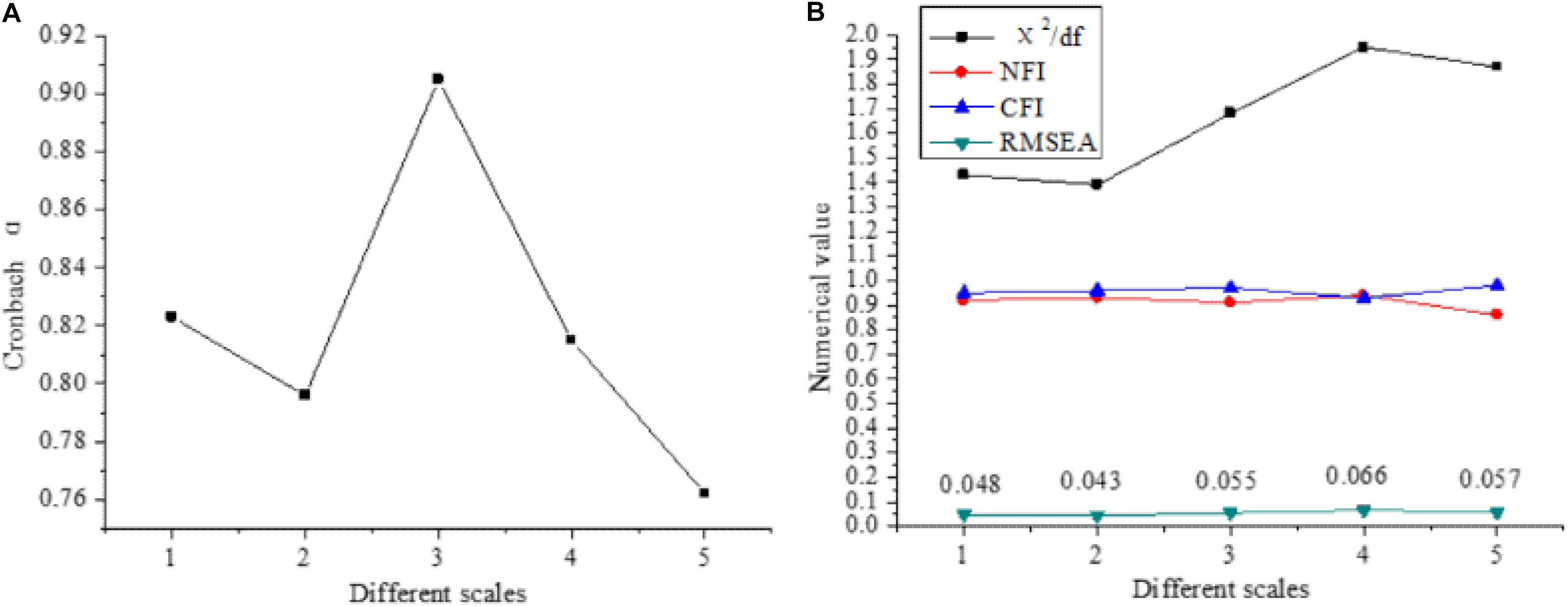
Figure 2. Reliability and validity analysis of the questionnaire [(A) reliability; (B) validity; 1: success motivation scale; 2: tolerance scale; 3: risk bias scale; 4: control tendency scale; 5: self-confidence scale].
Figure 2 shows that the Cronbach’s α of each scale is between 0.76 and 0.92, χ2/df is less than 2, and MSEA is more than 0.05. The results show that the reliability of the scale is high and has a good fitting ability.
Descriptive Statistics of the Personal Information of New Entrepreneurs
First, descriptive statistics of the genders of entrepreneurs are made, and the results are shown in Figure 3.
Figure 3 indicates that the gender ratio of the samples selected is seriously unbalanced, with 169 men entrepreneurs and only 31 women entrepreneurs. This may attribute to the low level of economic development and the lack of an advanced cultural atmosphere, taking men as the main force in entrepreneurial activities.
Second, the descriptive statistics are made on the age of entrepreneurs, and the results are shown in Figure 4.
Figure 4 indicates that there are 18 entrepreneurs under the age of 30 years, accounting for 9% of the total; 127 entrepreneurs are between the age of 30 and 50 years, accounting for 63.5%; and 55 entrepreneurs are over 50 years, accounting for 27.5%. This shows that the age of the entrepreneurs is mainly between 30 and 50 years old.
Finally, the descriptive statistics are made on the education level of the entrepreneurs, and the results are shown in Figure 5.
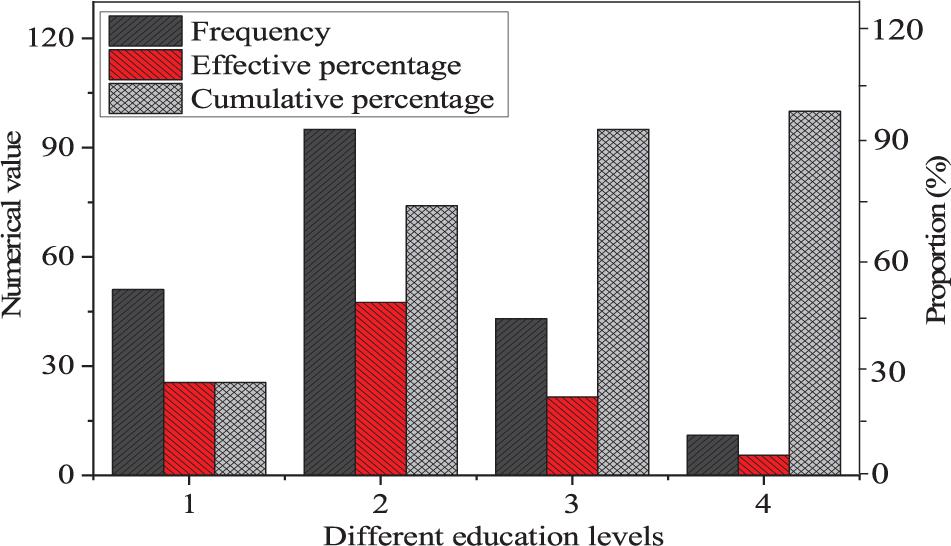
Figure 5. Descriptive statistics of the educational levels of entrepreneurs (1: senior high school or below; 2: junior college; 3: undergraduate; 4: postgraduate and above).
Most of the entrepreneurs are the ones with a junior college education, and the number is 95, accounting for 47.5%, that is, the proportion with a junior college education is the largest, which is consistent with the descriptive statistics of age group.
Results of the Psychological Characteristics and Entrepreneurial Performance of Entrepreneurs
The results of descriptive statistics on the score of the psychological characteristics of entrepreneurs are shown in Figure 6.
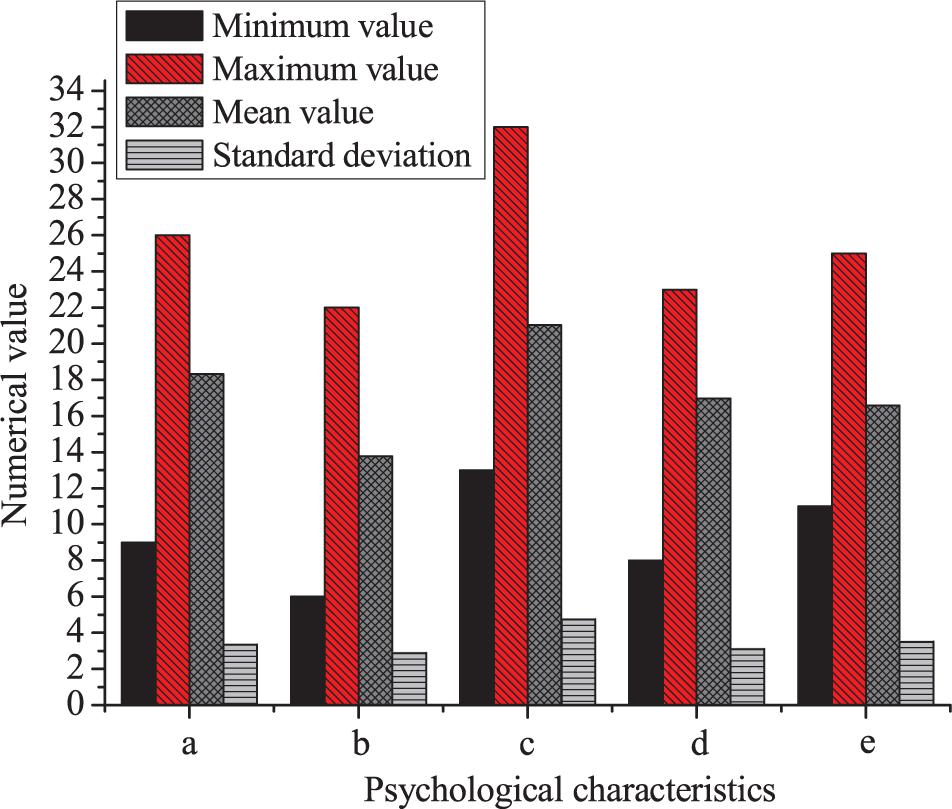
Figure 6. Statistical results of the scores of the psychological characteristics of entrepreneurs (a: success motivation; b: risk bias; c: tolerance; d: control tendency; e: self-confidence).
Figure 6 shows that the maximum value of the motivation for success is 26, the minimum is 9, the mean is 18.33, and the SD is 3.356. The maximum value of risk bias is 22, the minimum is 6, the mean is 13.77, and the SD is 2.897. The maximum value of tolerance is 32, the minimum is 13, the mean is 21.03, and the SD is 4.761. The maximum value of control disposition is 23, the minimum is 8, the mean is 16.97, and the SD is 3.115. The maximum value of self-confidence is 25, the minimum is 11, the mean is 16.58, and the SD is 3.526.
The results of descriptive statistics of the performance of entrepreneurs are shown in Figure 7.
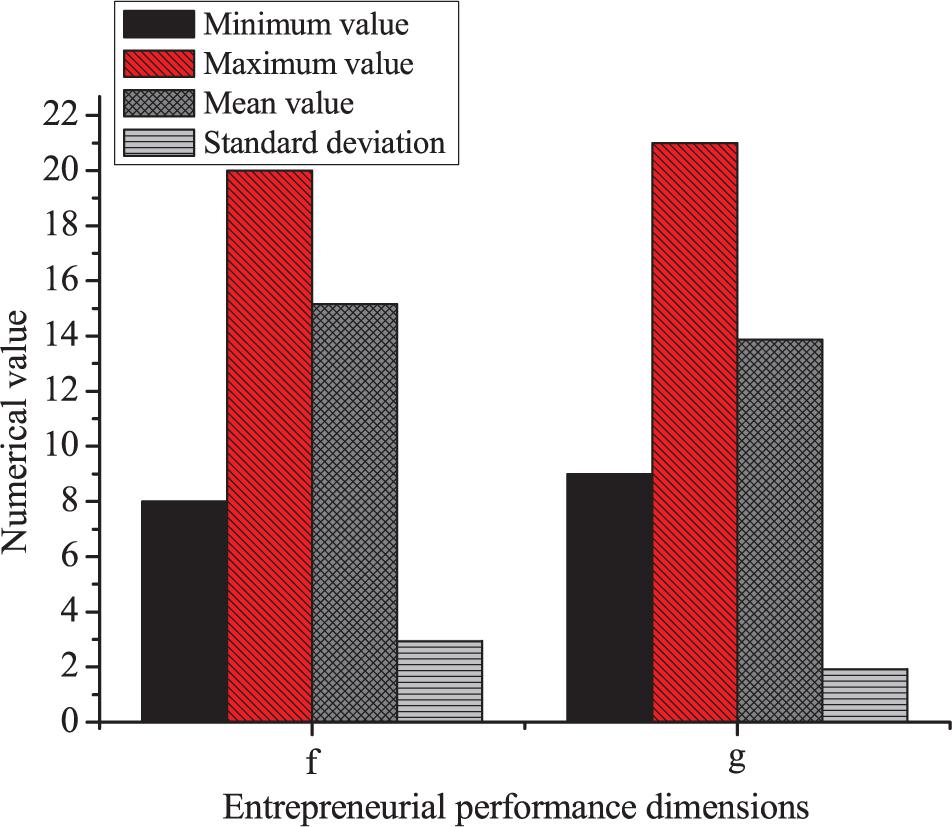
Figure 7. Statistical results of the entrepreneurial performance scale (f: developmental, g: profitable).
Figure 7 indicates the minimum value of developmental performance is 8, the maximum value is 20, the mean is 15.16, and the SD is 2.945. The minimum value of profitable performance is 9, the maximum is 21, the mean is 13.87, and the SD is 1.926.
Correlation Analysis of the Psychological Characteristics and Entrepreneurial Performance of Entrepreneurs
Hypotheses H1 and H2 are verified by correlation analysis, and the results are shown in Table 5.

Table 5. Pearson’s correlation coefficient of psychological characteristics and entrepreneurial performance.
Table 5 shows that the motivation for success has a significant correlation with risk bias on both sides at 0.05 level and has a significant correlation with tolerance, control tendency, self-confidence, development, and profitability at 0.01 level. Risk bias has a significant correlation with self-confidence and profitability; tolerance has a significant correlation with control tendency, development, and profitability; control tendency has a significant correlation with self-confidence and profitability; self-confidence has a significant correlation with development and profitability; development has a significant correlation with profitability, on both sides at 0.01 level.
The figure shows that the success motivation, risk bias, tolerance, control tendency, self-confidence, development, and profitability have significant effects on the psychological characteristics of new entrepreneurs. In the process of entrepreneurship, entrepreneurs have strong self-confidence and a desire for success. Only in this way can entrepreneurs pay attention to risk control, enterprise development, and tolerance of employees, maintaining the growth of business performance and long-term development.
Analysis of the Influence of the Related Control Variables
The impact of the genders of entrepreneurs on different variables is analyzed, and the results are shown in Figures 8A,B.
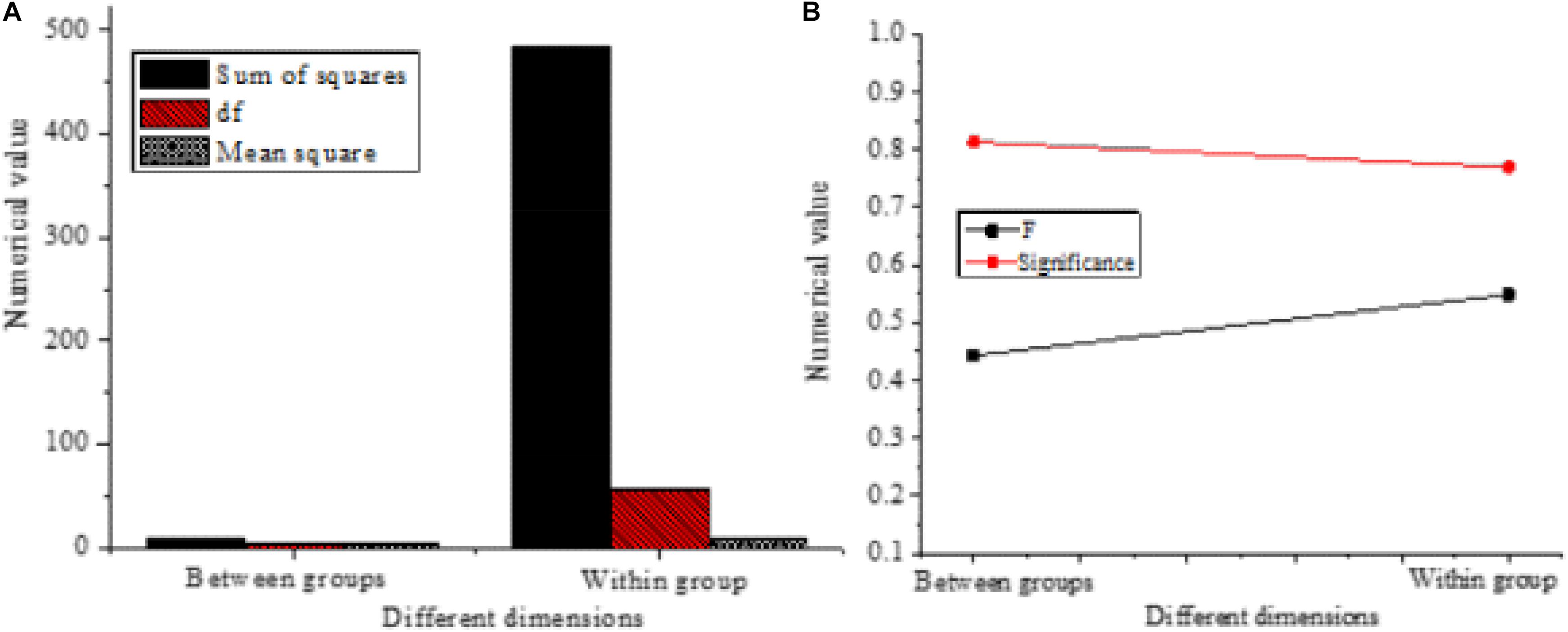
Figure 8. Influence of the genders of entrepreneurs on different variables. (A) t-test results of mean equation of different variables affected by entrepreneur gender. (B) Levene test results of variance equation of different variables affected by entrepreneur gender.
Figure 8A, show that the F values of the overall test are 0.443 (P = 0.813 > 0.05) and 0.549 (P = 0.769 > 0.05), respectively, which are not significant, indicating that the gender of new entrepreneurs has little impact on entrepreneurial performance.
Subsequently, the influence of the ages of entrepreneurs on different variables is analyzed, and the results are shown in Figures 9A,B.

Figure 9. Influence of the ages of entrepreneurs on different variables. (A) t-test results of the mean equation of different variables affected by entrepreneur age. (B) Levene test results of the variance equation of different variables affected by entrepreneur age.
The F values of the overall test are 5.131 (P = 0.023 < 0.05) and 2.951 (P = 0.047 < 0.05), and both are significant, indicating that the ages of entrepreneurs have a great impact on entrepreneurial performance.
Finally, the influence of the education levels of entrepreneurs on different variables is analyzed, and the results are shown in Figures 10A,B.
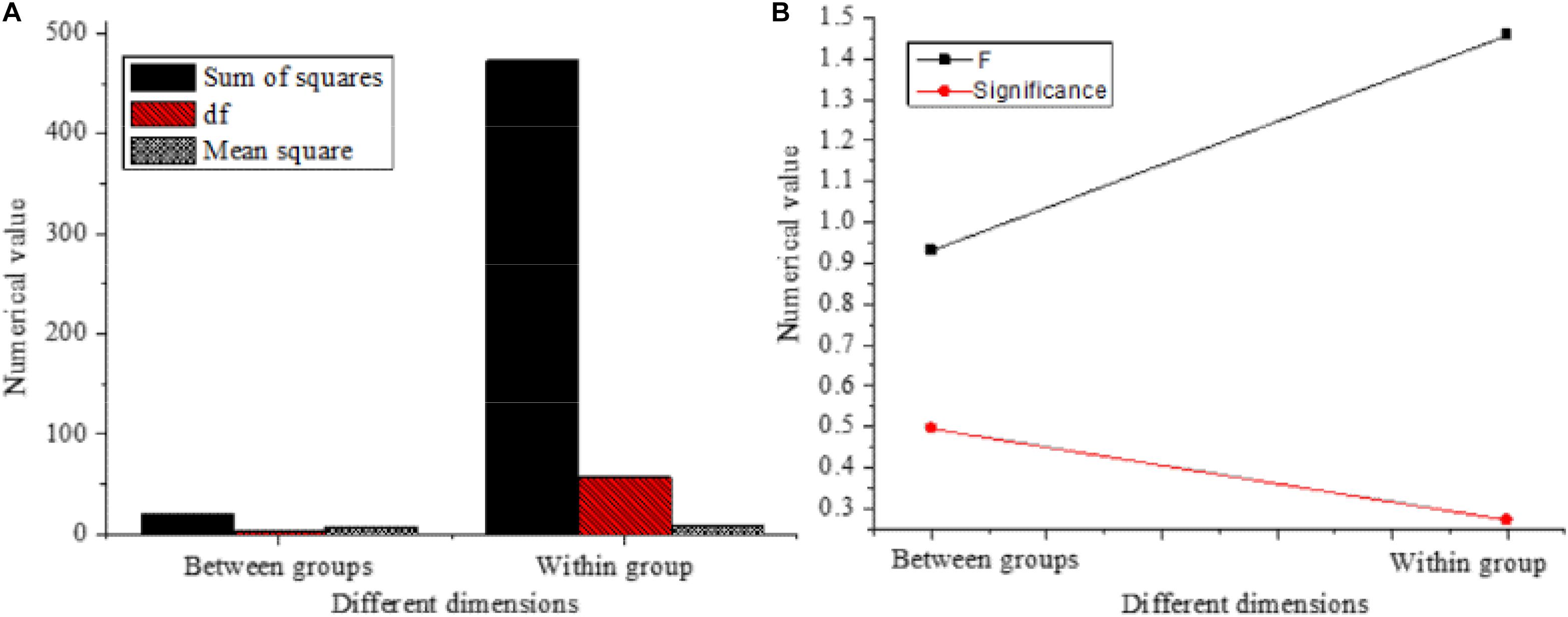
Figure 10. Influence of the education level of entrepreneurs on different variables. (A) t-test results of the mean equation of different variables affected by entrepreneurs’ education. (B) Levene test results of the variance equation of different variables affected by entrepreneurs’ education.
The F values of the overall test in Figure 10 are 0.931 (P = 0.495 > 0.05) and 1.457 (P = 0.272 > 0.05), respectively, which are not great, indicating that the education levels of the new entrepreneurs have no significant impact on entrepreneurial performance.
Based on the above, it is concluded that the male-to-female ratio of the entrepreneurs is 169:31, which may be due to the relatively backward cultural atmosphere of entrepreneurship caused by the low level of economic development in the region, making the participants in entrepreneurial activities mainly men; 47.5% of the new entrepreneurs have a college education. Tolerance is scored the highest, which is consistent with the descriptive statistics of ages. That is, older entrepreneurs generally have strong tolerance, which is consistent with the results of Ruiu and Breschi (2019). This study shows that the probability of entrepreneurship of entrepreneurs increases with age (35–44 years old), and the tolerance of entrepreneurs also increases (Ruiu and Breschi, 2019). There is little difference between the maximum scores of developmental performance and profit-seeking performance in entrepreneurial performance of new entrepreneurs, indicating that the new entrepreneurs attach great importance to the development and profit-seeking of enterprises. There is a significant positive correlation between the psychological characteristics of new entrepreneurs and entrepreneurial performance, that is, the psychological characteristics of new entrepreneurs have an impact on the development and profitability of the enterprise, which is consistent with the opinions of Garaika et al. (2019). The results show that the self-efficacy and self-personality of new entrepreneurs have a certain impact on entrepreneurial intention and enterprise efficiency (Garaika et al., 2019).
Conclusion
Based on the industrial cluster theory in the new era, the research status of the correlation between the psychological characteristics of new entrepreneurs and the performance of new ventures is analyzed, and then the relevant research model is established and two hypotheses are given. Through questionnaire survey and correlation analysis, the hypotheses are verified. It is found that the gender ratio of entrepreneurs in the research object is seriously unbalanced; gender and education have no significant impact on entrepreneurial performance, whereas age has a significant impact on entrepreneurial performance. There is a significant correlation between different types of entrepreneurial psychological characteristics and the two dimensions of entrepreneurial performance.
In the new era of the industrial cluster environment, the cultivation of the psychological characteristics of the new entrepreneurs should be paid attention to; and the self-confidence, the motivation to pursue success, and the ability of risk forecast and control of the entrepreneurs need to be cultivated. The attitude of the leaders toward employees should be tolerant, and the employees are allowed to make mistakes so that their entrepreneurial performance is improved and higher entrepreneurial value is achieved. However, there are some shortcomings in this study. For example, the scope and quantity of the entrepreneur survey are relatively limited, and the dimension analysis of entrepreneurial performance is not enough, which is the content that needs to be analyzed in the next research plan.
Data Availability Statement
The raw data supporting the conclusions of this article will be made available by the authors, without undue reservation.
Ethics Statement
The studies involving human participants were reviewed and approved by the Henan University of Technology Ethics Committee. The patients/participants provided their written informed consent to participate in this study. Written informed consent was obtained from the individual(s) for the publication of any potentially identifiable images or data included in this article.
Author Contributions
The author confirms being the sole contributor of this work and has approved it for publication.
Funding
This research was supported by the Soft Science Fund Project of Henan Provincial Science and Technology Department: Research on the Coupling Path of Innovation Drive and Upgrading of Henan Manufacturing Cluster (Project No. 202400410080) and Humanities and Social Science Research Project of Henan Provincial Department of Education: Research on the Coupling of Government Environmental Regulation and Corporate Social Responsibility in the Middle and Lower Reaches of the Yellow River (2021-ZZJH-080).
Conflict of Interest
The author declares that the research was conducted in the absence of any commercial or financial relationships that could be construed as a potential conflict of interest.
Publisher’s Note
All claims expressed in this article are solely those of the authors and do not necessarily represent those of their affiliated organizations, or those of the publisher, the editors and the reviewers. Any product that may be evaluated in this article, or claim that may be made by its manufacturer, is not guaranteed or endorsed by the publisher.
References
Chen, M. (2019). The Impact of Expatriates’ Cross-Cultural Adjustment on Work Stress and Job Involvement in the High-Tech Industry. Front. Psychol. 10:2228. doi: 10.3389/fpsyg.2019.02228
Chen, X., and Xin, X. (2019). The core of China’s rural revitalization: exerting the functions of rural area. China Agric. Econ. Rev. 12, 1–13. doi: 10.1108/CAER-02-2019-0025
Chen, Y. M., Liu, H. H., and Chiu, Y. C. (2017). Customer benefits and value creation in streaming services marketing: a managerial cognitive capability approach. Psychol. Mark. 34, 1101–1108. doi: 10.1002/mar.21050
Felice, G. D., Giuliani, A., Halfon, S., Andreassi, S., Paoloni, G., and Orsucci, F. F. (2019). The misleading Dodo Bird verdict. How much of the outcome variance is explained by common and specific factors?. New Ideas Psychol. 54, 50–55. doi: 10.1016/j.newideapsych.2019.01.006
Friedman, N. P., Miyake, A., Altamirano, L. J., Corley, R. P., Young, S. E., Rhea, S. A., et al. (2016). Stability and Change in Executive Function Abilities From Late Adolescence to Early Adulthood: a Longitudinal Twin Study. Dev. Psychol. 52:326. doi: 10.1037/dev0000075
Garaika, G., Margahana, H. M., and Negara, S. T. (2019). Self Efficacy, Self Personality And Self Confidence On Entrepreneurial Intention: study On Young Enterprises. J. Entrep. Educ. 22, 1–12.
Hashai, N., and Markovich, S. (2017). Market Entry by High Technology Startups: the Effect of Competition Level and Startup Innovativeness. Strateg. Sci. 2, 141–160. doi: 10.1287/stsc.2017.0033
Heinz, A. J., Freeman, M. A., Harpaz-Rotem, I., and Pietrzak, R. H. (2017). American Military Veteran Entrepreneurs: a Comprehensive Profile of Demographic, Service History, and Psychosocial Characteristics. Mil. Psychol. 29, 513–523. doi: 10.1037/mil0000195
Iodice, E., Spavone, M., Cantiello, M., Abrusco, R. D., Capaccioli, M., Hilker, M., et al. (2017). Intracluster Patches of Baryons in the Core of the Fornax Cluster. Astrophys. J. 851:75. doi: 10.3847/1538-4357/aa9b30
Labrador, F. J., Bernaldo-De-Quirós, M., García-Fernández, G., EstupiÁ, F., Fernández-Arias, I., and Labrador-Méndez, M. (2016). Characteristics of demand and psychological treatments in a university clinic. Clín. Salud 56, 7–14. doi: 10.1016/j.clysa.2016.01.002
Link, J. S., and Lashley, L. K. (2016). Clinical Utility and Characteristics of the Brown Location Test for Individuals With Right Temporal Lobe Epilepsy. Rehabil. Psychol. 61:345. doi: 10.1037/rep0000100
Lv, T., Wang, L., Xie, H., Zhang, X. M., and Zhang, Y. W. (2021). Exploring the Global Research Trends of Land Use Planning Based on a Bibliometric Analysis: current Status and Future Prospects. Land 10:304. doi: 10.3390/land10030304
Mayhew, M. J., Simonoff, J. S., Baumol, W. J., Selznick, B. S., and Vassallo, S. J. (2016). Cultivating innovative entrepreneurs for the twenty-first century: a study of U.S. and German students. J. High. Educ. 87, 420–455. doi: 10.1080/00221546.2016.11777408
Mooradian, T., Matzler, K., Uzelac, B., and Bauer, F. (2016). Perspiration and inspiration: grit and innovativeness as antecedents of entrepreneurial success. J. Econ. Psychol. 56, 232–243. doi: 10.1016/j.joep.2016.08.001
Ogas, E., Avila, L., Larregay, G., and Moran, D. (2019). A grasp detection method for industrial robots using a Convolutional Neural Network. IEEE Lat. Am. Trans. 17, 1509–1516. doi: 10.1109/TLA.2019.8931145
Or, M. B., Ishai, R., and Levi, N. (2015). The symbolic content in adults’ PPAT as related to attachment styles and achievement motivation. Arts Psychother. 43, 49–60. doi: 10.1016/j.aip.2014.12.005
Panda, S., and Nagendra, S. (2017). Assimilative Capacity Based Emissions Load Management In A Critically Polluted Industrial Cluster. J. Air Waste Manag. Assoc. 67, 1353–1363. doi: 10.1080/10962247.2017.1372319
Park, S. C. (2017). The Fourth Industrial Revolution and implications for innovative cluster policies. Ai. Soc. 33, 433–445. doi: 10.1007/s00146-017-0777-5
Przepiorka, A. M. (2016). Psychological Determinants of Entrepreneurial Success and Life-Satisfaction. Curr. Psychol. 36, 304–315. doi: 10.1007/s12144-016-9419-1
Qu, T., Nie, D. X., Li, C. D., Matthias, T., and Huang, G. Q. (2017). Optimal Configuration of Assembly Supply Chains Based on Hybrid Augmented Lagrangian Coordination in an Industrial Cluster. Comput. Ind. Eng. 112, 511–525. doi: 10.1016/j.cie.2017.03.003
Ratna, J. (2018). An Aretaic Jurisprudence Approach to the Character of the Secretary-General of the United Nations as a Norm Entrepreneur to Save the Earth from the Adverse Impact of Climate Change. Korean J. Int. Comp. Law 6, 30–46. doi: 10.1163/22134484-12340096
Redondo, J. M. (2019). Improving Student Assessment of a Server Administration Course Promoting Flexibility and Competitiveness. IEEE Trans. Educ. 62, 19–26. doi: 10.1109/TE.2018.2816571
Rogoza, R., Żemojtel-Piotrowska, M., Kwiatkowska, M. M., and Kwiatkowska, K. (2018). The Bright, the Dark, and the Blue Face of Narcissism: the Spectrum of Narcissism in Its Relations to the Metatraits of Personality, Self-Esteem, and the Nomological Network of Shyness, Loneliness, and Empathy. Front. Psychol. 9:343. doi: 10.3389/fpsyg.2018.00343
Ruiu, G., and Breschi, M. (2019). The Effect of Aging on the Innovative Behavior of Entrepreneurs. J. Knowl. Econ. 10, 1784–1807. doi: 10.1007/s13132-019-00612-5
Shen, Y., Wang, L., Fu, J., Xu, X., and Li, J. (2019). Population structure, demographic history and local adaptation of the grass carp. BMC Genom. 20:467. doi: 10.1186/s12864-019-5872-1
Torres-Coronas, T., and Vidal-Blasco, M.-A. (2016). The role of trait emotional intelligence in predicting networking behavior. Revista Brasileira de Gestão de Negócios 19, 30–47. doi: 10.7819/rbgn.v0i0.3127
Wu, T., and Wu, Y. (2019). Innovative Work Behaviors, Employee Engagement, and Surface Acting: a Delineation of Supervisor-Employee Emotional Contagion Effects. Manag. Decis. 57, 3200–3216. doi: 10.1108/MD-02-2018-0196
Wu, W., Wang, H., Zheng, C., and Wu, Y. J. (2019). Effect of Narcissism, Psychopathy, and Machiavellianism on Entrepreneurial Intention - The Mediating of Entrepreneurial Self-Efficacy. Front. Psychol. 10:360. doi: 10.3389/fpsyg.2019.00360
Wu, Y., and Song, D. (2019). Gratifications for Social Media Use in Entrepreneurship Courses: learners’ Perspective. Front. Psychol. 10:1270. doi: 10.3389/fpsyg.2019.01270
Yang, Z., and Dunford, M. (2017). Cluster evolution and urban industrial dynamics in the transition from a planned to a socialist market economy: the case of Beijing. Spat. Econ. Anal. 12, 50–71. doi: 10.1080/17421772.2016.1242152
Yuan, C.-H., Wang, D., Mao, C., and Wu, F. (2020). An empirical comparison of graduate entrepreneurs and graduate employees based on graduate entrepreneurship education and career development. Sustainability 12:10563. doi: 10.3390/su122410563
Keywords: industrial cluster theory, multidimensional structure model, new entrepreneurs, psychological characteristics, entrepreneurial value
Citation: Fan H (2021) Psychological Construction and Cultivation of New Entrepreneurs Using Industrial Cluster Theory and Multidimensional Structure Model. Front. Psychol. 12:693377. doi: 10.3389/fpsyg.2021.693377
Received: 10 April 2021; Accepted: 20 July 2021;
Published: 25 August 2021.
Edited by:
Chih-Hung Yuan, University of Electronic Science and Technology of China, Zhongshan Institute, ChinaReviewed by:
Teresa Dieguez, Instituto Politécnico do Cávado e do Ave, PortugalMary Nina Wang, University of Malaya, Malaysia
Congchong Viru Liu, Wonkwang University, South Korea
Copyright © 2021 Fan. This is an open-access article distributed under the terms of the Creative Commons Attribution License (CC BY). The use, distribution or reproduction in other forums is permitted, provided the original author(s) and the copyright owner(s) are credited and that the original publication in this journal is cited, in accordance with accepted academic practice. No use, distribution or reproduction is permitted which does not comply with these terms.
*Correspondence: Huiling Fan, ZmFubGF1Z2hAMTYzLmNvbQ==
 Huiling Fan
Huiling Fan